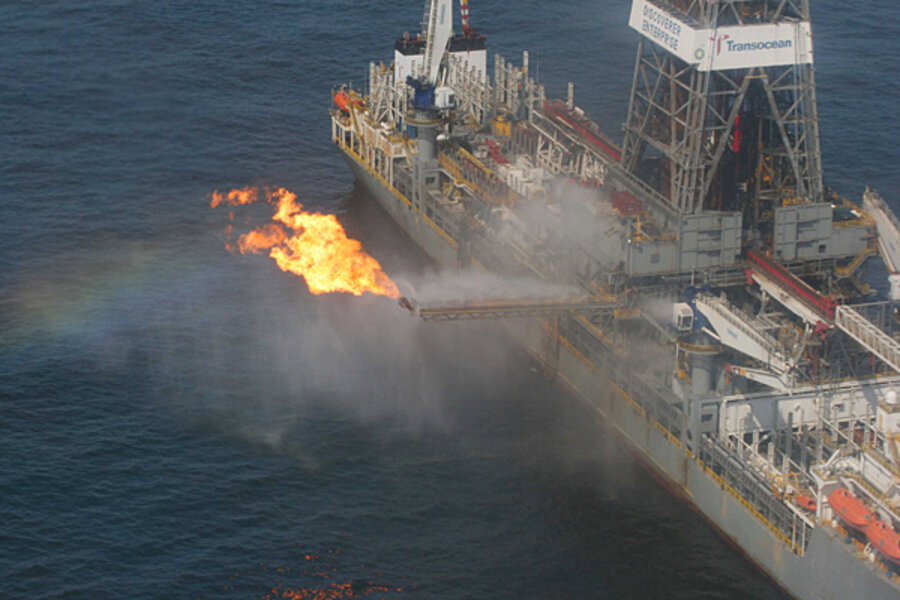Gulf oil spill: Why BP's cap success is turning sour
Loading...
Recent days have portrayed BP as a company struggling to deal even with its own successes.
Since the Gulf oil spill began with an explosion on the Deepwater Horizon oil rig April 20, positive news has been in short supply for BP. From the apparently forward-at-all-costs origins of the accident to repeatedly low-ball flow estimates of the leak and a series of failed attempts to kill the well, the company has fought a losing public relations campaign, dropping 40 percent of its stock-market value in the past 51 days.
Now, even the good news that its new containment cap is working is being tempered by missteps and doubts.
IN PICTURES: Sticky mess - The Gulf oil spill's impact on nature
On Wednesday, the cap was collecting 630,000 gallons of oil – but it could be capturing more oil if BP had decided to put more ships on the surface to hold and process the collected oil. That means the cap will have to continue venting excess oil into the Gulf until another two ships – one which can sift gas and water out of the crude and another which will shuttle oil to shore – arrive next week.
Moreover, the BP live cam at the well is raising questions about whether the top cap operation made the situation worse. BP had to cut off a pipe in order to fit the cap on the well. But many scientists think that pipe was restricting the flow of oil into the Gulf. So while the cap might be collecting large amounts of oil, the increased flow rate might mean that more oil is actually entering the Gulf than before.
Flow rate: It was important, after all
At the very least, BP erred by underestimating the size of the geyser and even downplaying the flow rate's importance, says one scientist.
"They're groping in the dark because they've never permitted actual estimates to be made," Ian MacDonald, a Florida state oceanographer, told ABC News on Tuesday. "They said a dozen times on television that 5,000 barrels a day was the rate of this spill, and all their engineering was driven by that. Clearly, they were underestimating what kind of capacity they needed."
In response to reports that BP isn't capturing all the oil it could, the Coast Guard on Wednesday ordered BP to come up with a plan in the next 72 hours to completely capture and contain all the leaking oil. "Current collection efforts may not be interrupted to implement these plans," Coast Guard Rear Adm. James Watson wrote.
Meanwhile, a National Oceanic and Atmospheric Administration (NOAA) Flow Rate Technical Group is furiously assembling a new flow study that could show the effect of last week's "top cap" maneuver.
Unfounded optimism?
For BP, bursts of corporate optimism aimed at the stock market have been consistently tempered by the stark geological and technical realities playing out 5,000 feet under the Gulf. This has compounded the frustrations of Americans who are sensing corporate spin when they want truthful answers about the spill.
For example, executive Doug Suttles said the collection system "is right where we want to be" – despite the fact that it is still apparently hemorrhaging hundreds of thousands of gallons of oil into the Gulf daily. He went on to add that the well would be a reduced to a "relative trickle" next week. On Wednesday, BP backed off this claim, saying that it only wants to have an improved collection system in place by then.
Moreover, NOAA reported Tuesday that a US research boat had confirmed reports of massive undersea plumes of oil, some as deep as 3,000 feet – this, after BP chief Tony Hayward bluntly said on May 30 that "there aren't any plumes."
NOAA said the density of the oil is not high and that microbes are ravenously consuming the spill. Suttles told ABC News "Good Morning America" that those findings, in fact, jibed with BP's own assessment. "What NOAA talked about yesterday was very consistent with what we've measured and we've seen," Suttles said. "No one has yet found any concentration that measured higher than the parts per million. It may be how you're defining [an oil plume.]"
One possible problem, though, is that the gorging microbes might create oxygen-starved "dead zones" in the Gulf.
To be sure, Mr. Hayward, whose breezy British style has failed to charm more earnest and horrified Americans, "seems not to have tempered his message to his audience," writes Richard Northedge on the British Director of Finance Online website.
Yet Mr. Northedge suggests that BP is not getting enough credit for the things it is doing right. He contrasts Obama's angry lashings at the company against the response from BP, "which has accepted responsibility from the start – even for actions by other companies – and whose efforts are on plugging the leak and cleaning the coast rather than criticizing others."
The BP live feed, which shows multiple views of the runaway well on the Internet, is an unprecedented attempt at corporate transparency – though it took congressional pressure for the company to post the feed. BP has also said it will donate the profits from the recovered oil directly to a wildlife cleanup fund.
Related:
- BP live feed doesn't lie: Is BP oil spill plume worse than before?
- Gulf oil spill: Why is it so hard to stop?
- What BP needs to do to salvage its oil-drenched image
IN PICTURES: Sticky mess - The Gulf oil spill's impact on nature





